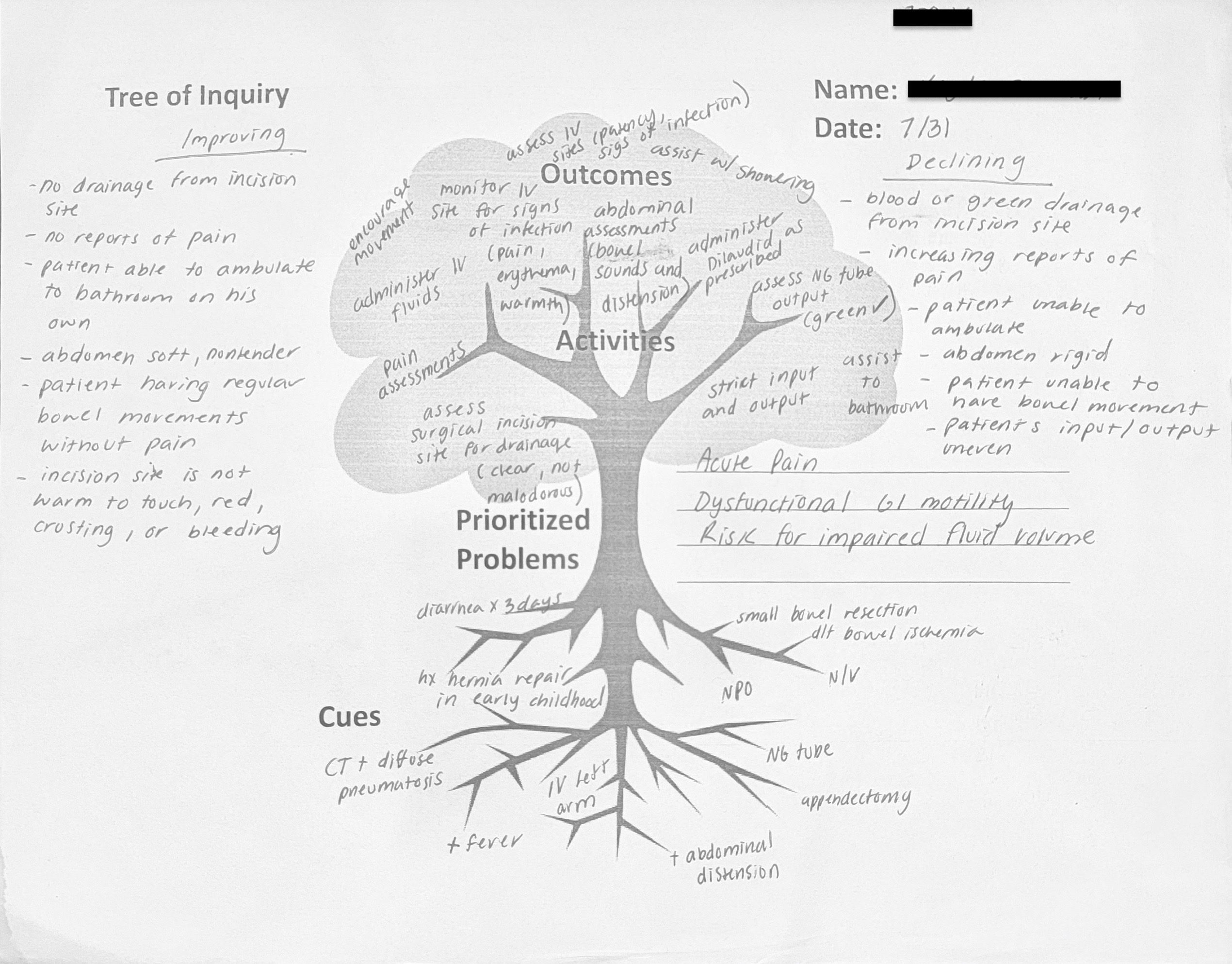In this issue of Changing Course, we will examine how to grow clinical judgment with trees. The change to the Next Generation NCLEX (NGN) is quickly approaching and students currently enrolled in nursing programs must be ready to pass the redesigned licensing exam. Clinical judgment must be cultivated at the onset of the educational journey to ensure success on the NGN, but more importantly to graduate nurses that are ready for practice. The Tree of Inquiry builds on an existing strategy to foster clinical judgment through deep thinking, decision making, and demonstration of nursing competencies.
The Tree of Inquiry is based on the Tree of Impact decision tree tool. It was presented in 2001 as a nursing education strategy by Lowenstein et al. and subsequently modified by Assessment Technologies Institute (ATI) (2015). I was first introduced to the Tree of Impact at the 2022 ATI National Nurse Educator Summit. The Tree of Inquiry has a foundation in the Nursing Clinical Judgment Measurement Model (NCJMM). It also supports Universal Design for Learning principles through:
-
Multiple Means of Engagement: it is an individual or collaborative activity that can be used in the classroom, laboratory, or clinical setting
-
Multiple Means of Representation: students use visual, textual, and auditory means to complete the activity
-
Multiple Means of Action and Expression: it can be typed or handwritten and supports strategy development and the use of executive functions
(CAST, 2022).
Using the Tree of Inquiry as an educational strategy is easy to do. It is designed to be used with patient scenarios and can be applied to currently used case studies, simulations, and clinical practice. When used repeatedly as a teaching strategy across the curriculum, the Tree of Inquiry can reframe student thinking patterns. The Tree of Inquiry is pictured below.

With the Tree of Inquiry, students:
-
Identify and prioritize patient Cues
-
Identify priority nursing Problems
-
Plan and Implement nursing Activities
-
Evaluate the Outcomes of the implemented activities
Cues
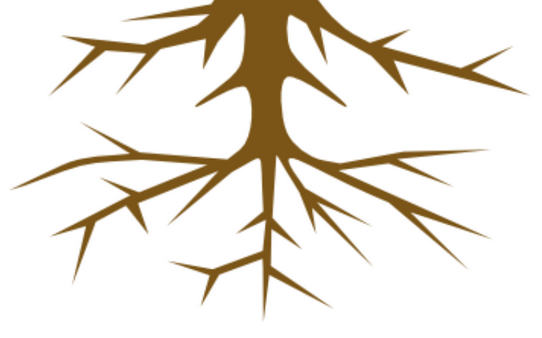 According to the National Council of State Boards of Nursing (NCSBN) (2019), cues are relevant and key information gathered from different sources. In the Tree of Inquiry, the cues form the roots of the tree and are the foundation from which the tree, or plan of care, grows. Students analyze the cues to identify and hypothesize problems to address. Examples of cues include assessment findings, laboratory or testing data, psychosocial and medical history, and background information.
According to the National Council of State Boards of Nursing (NCSBN) (2019), cues are relevant and key information gathered from different sources. In the Tree of Inquiry, the cues form the roots of the tree and are the foundation from which the tree, or plan of care, grows. Students analyze the cues to identify and hypothesize problems to address. Examples of cues include assessment findings, laboratory or testing data, psychosocial and medical history, and background information.
Problems
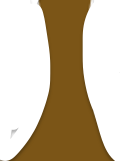 Problems deal with human responses to actual and potential health issues and life processes and fall within the nursing scope of practice (American Nurses Association [ANA], 2021). After problems are identified and prioritized, they are placed in the trunk of the tree. The trunk serves as the main structure of the tree, facilitating transport of water and nutrients from the roots to the leaves and sugar from the leaves to the roots (Arbor Day Foundation, 2022). In the Tree of Inquiry, the trunk serves as the in-between point for the cues and the activities, as the problems are directly related to the cues and the activities are directly related to the problems. The trunk is where solutions are generated and pushed up through the branches to become activities. Examples of problems include risk for injury, pain, anxiety, and impaired skin integrity.
Problems deal with human responses to actual and potential health issues and life processes and fall within the nursing scope of practice (American Nurses Association [ANA], 2021). After problems are identified and prioritized, they are placed in the trunk of the tree. The trunk serves as the main structure of the tree, facilitating transport of water and nutrients from the roots to the leaves and sugar from the leaves to the roots (Arbor Day Foundation, 2022). In the Tree of Inquiry, the trunk serves as the in-between point for the cues and the activities, as the problems are directly related to the cues and the activities are directly related to the problems. The trunk is where solutions are generated and pushed up through the branches to become activities. Examples of problems include risk for injury, pain, anxiety, and impaired skin integrity.
Activities
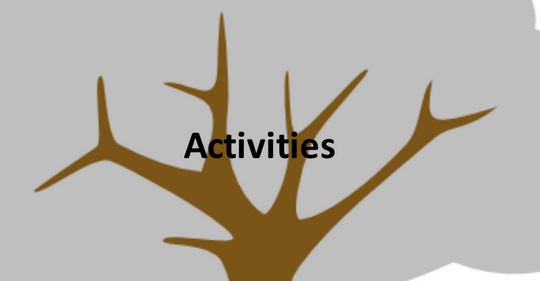 Activities are the solutions, or actions, that address the highest priorities (NCSBN, 2019). Activities are placed on the branches as they produce the outcomes, which are the leaves. Examples of activities include administering medications, turning a patient and providing education.
Activities are the solutions, or actions, that address the highest priorities (NCSBN, 2019). Activities are placed on the branches as they produce the outcomes, which are the leaves. Examples of activities include administering medications, turning a patient and providing education.
Outcomes
 Outcomes are the patient’s response to the activities (NCSBN, 2019). Observed or potential outcomes should be evaluated and compared to expected outcomes. Students are prompted to anticipate outcomes that indicate the patient’s condition is getting better, worse, or remaining the same. Outcomes are placed on the leaves of the tree, as the leaves are dependent on the branches like outcomes are dependent on the activities.
Outcomes are the patient’s response to the activities (NCSBN, 2019). Observed or potential outcomes should be evaluated and compared to expected outcomes. Students are prompted to anticipate outcomes that indicate the patient’s condition is getting better, worse, or remaining the same. Outcomes are placed on the leaves of the tree, as the leaves are dependent on the branches like outcomes are dependent on the activities.
You can download a Tree of Inquiry Handout here.
Examples
Here are four Tree of Inquiry assignments that I have implemented with success. Please feel free too use and share with proper attribution.
Health Equity and Social Determinants of Health
This activity was used in a beginning nursing course during a discussion about health equity and social determinants of health.
Case:
Instructions:
-
Complete the Tree of Inquiry using the provided case.
-
Cues
-
Individually, identify and prioritize “Cues”
-
Collaboratively, discuss “Cues”
-
Report out to class and discuss
-
-
Problems
-
Individually, identify and prioritize “Problems”
-
Collaboratively, discuss “Problems”
-
Report out to class and discuss
-
-
Activities
-
Individually, identify “Activities”
-
Collaboratively, discuss “Activities”
-
Report out to class and discuss
-
-
Outcomes
-
Individually, identify “Outcomes”
-
Collaboratively, discuss “Outcomes”
-
Report out to class and discuss
-
-
-
Recommendations: set time limits as appropriate, draw tree on a whiteboard with each stage
Sample Tree
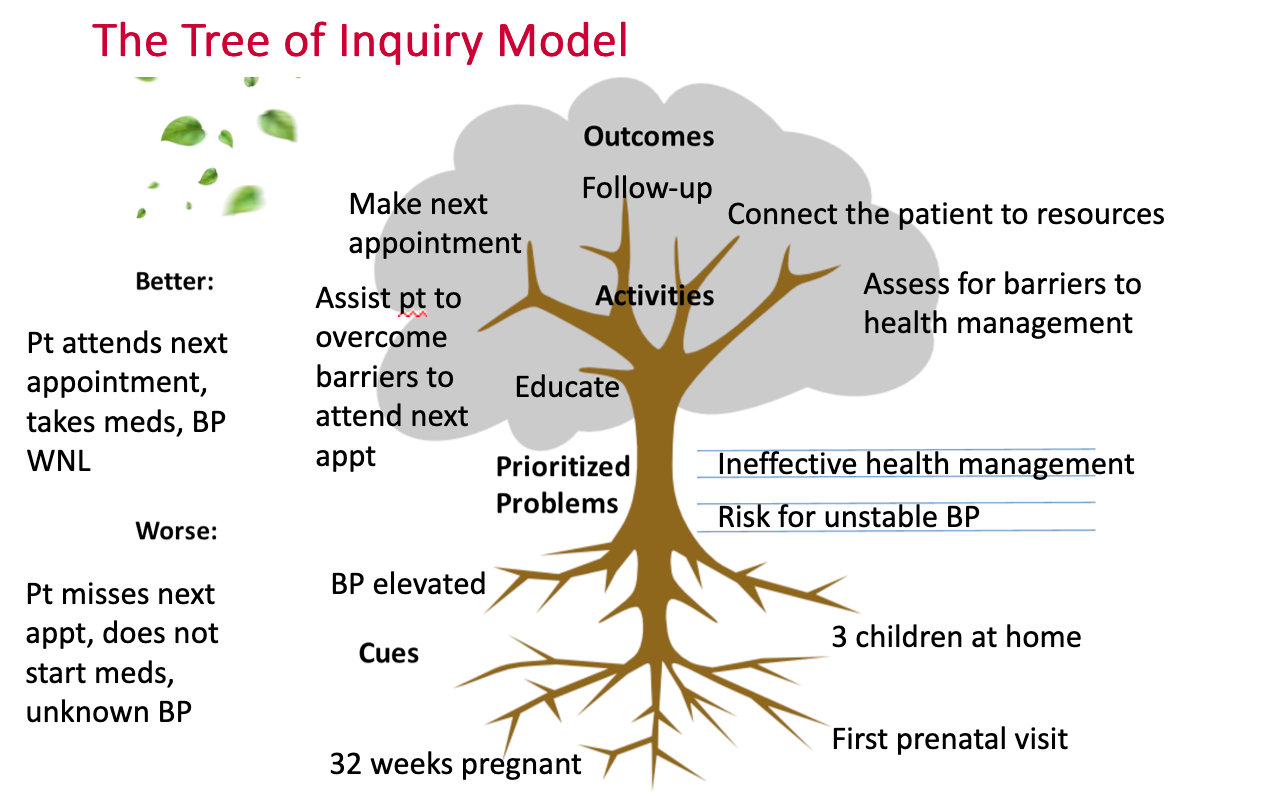
Clinical Activity
This activity is completed during clinical, as the student develops, implements, and evaluates the plan of care for the patient.
Instructions:
-
A Tree of Inquiry template must be completed for each assigned patient.
-
It is encouraged that students complete this template during the clinical day.
-
The information in this template will be discussed during post-conference.
-
Completed templates must be uploaded to the assignment within 48 hours of the clinical day.
Student Samples
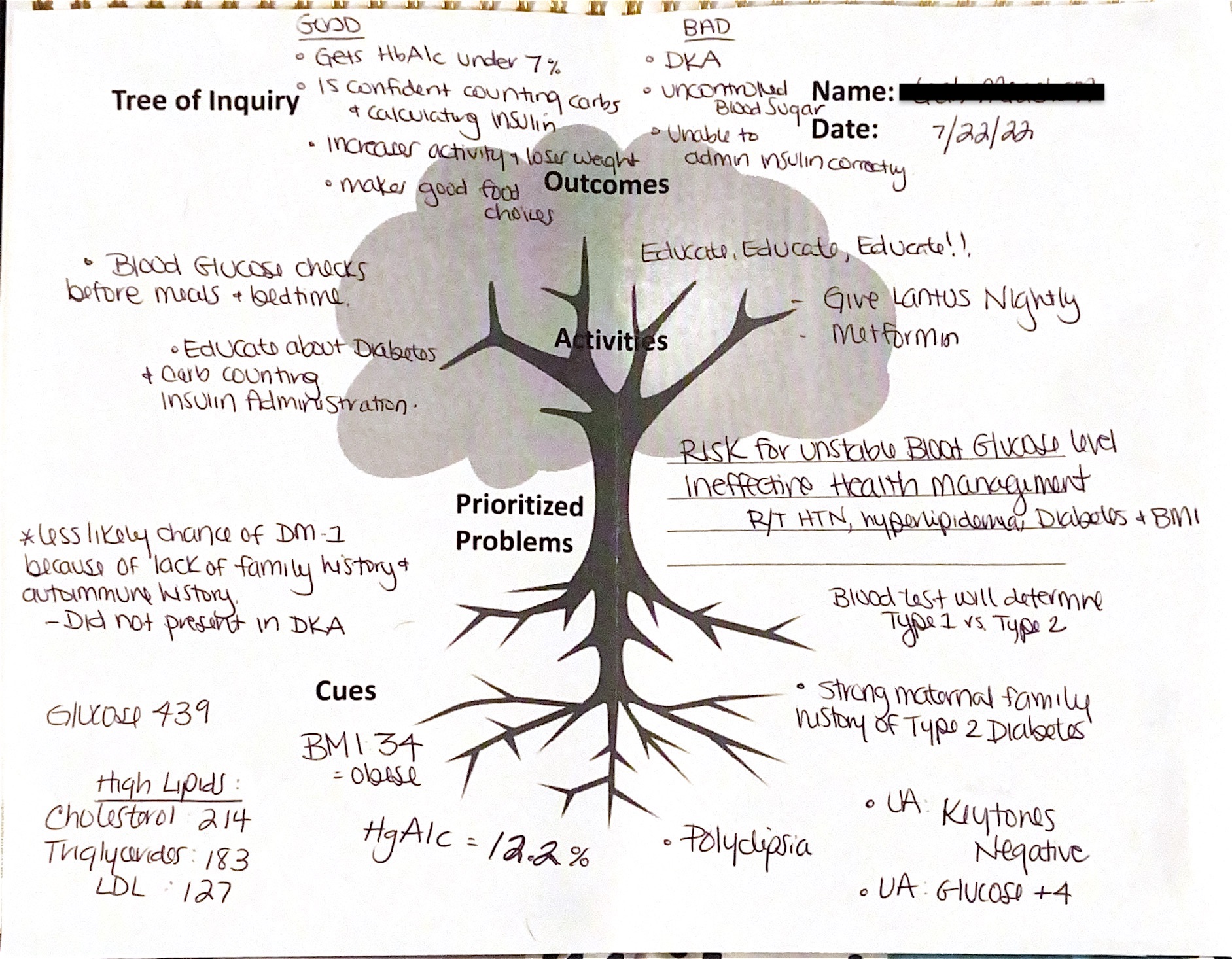
Data Mining Activity
This activity can be used during class or clinical. Students are provided with an electronic or paper medical record to review, then grow a plan of care using the Tree of Inquiry.
Student Sample
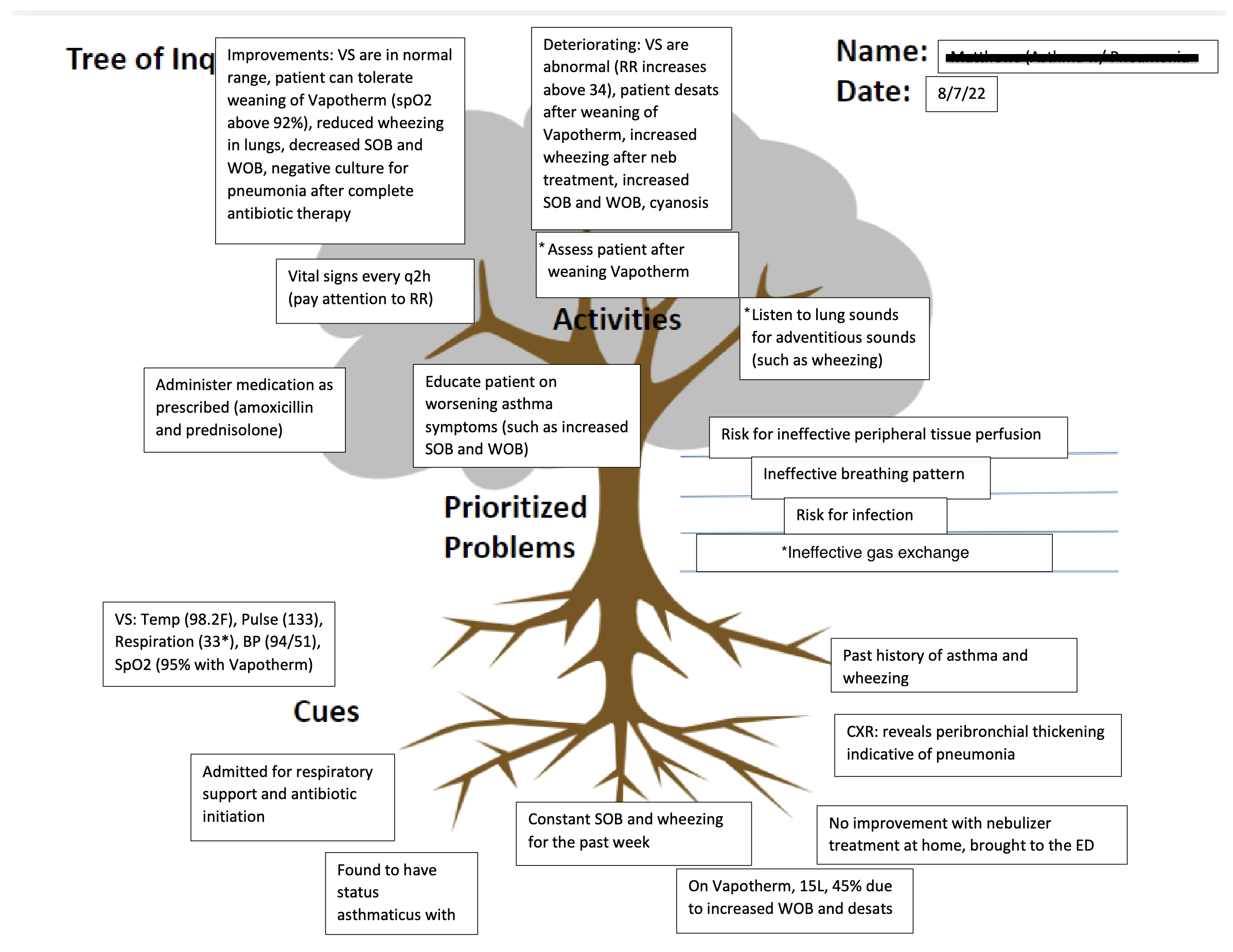
Disease/Disorder Activity
This activity can be used during class or clinical. Students are given a disease/disorder, then grow a plan of care using the Tree of Inquiry.
Sample Tree: RSV
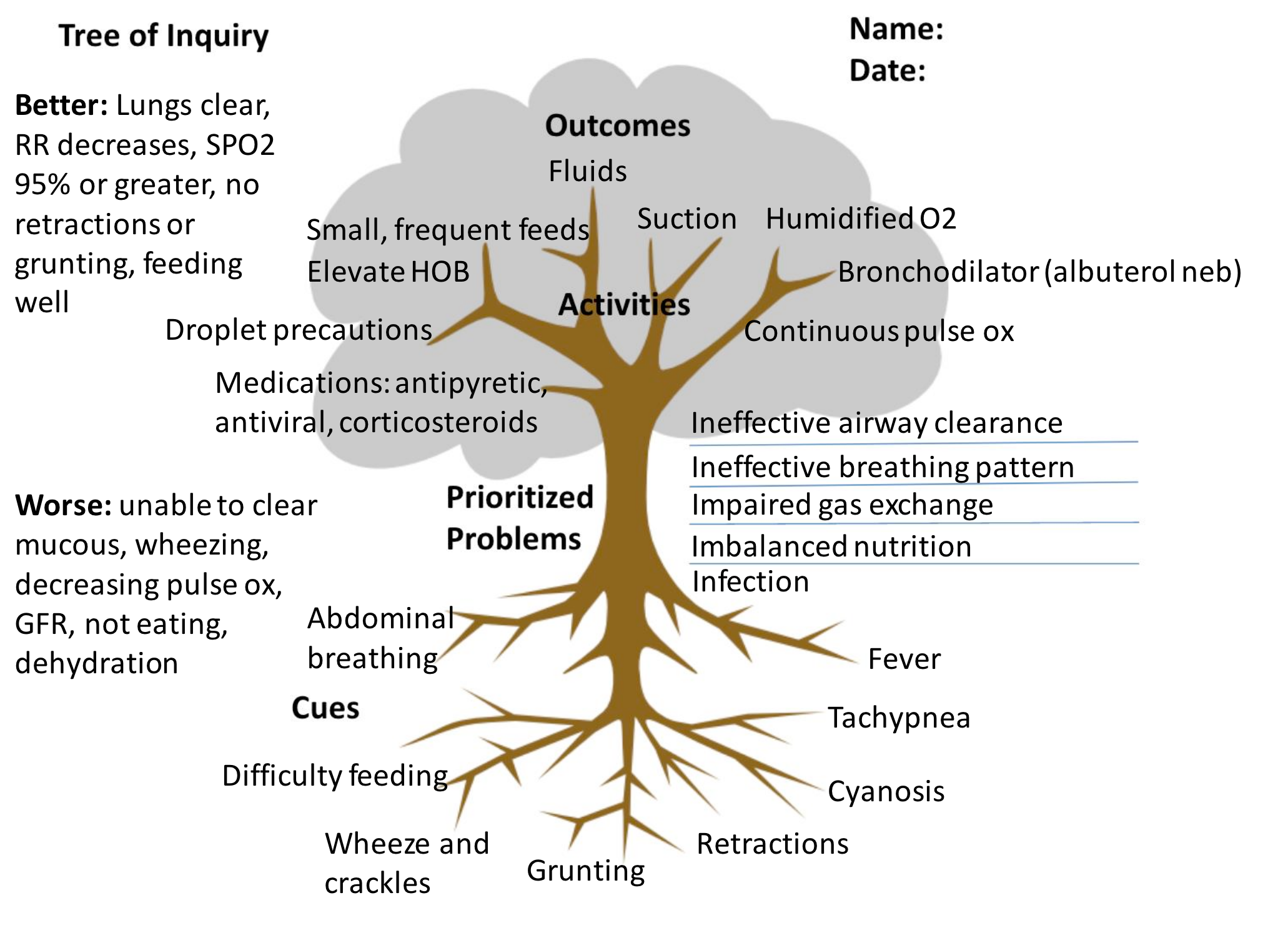
Mastery Demonstration
The Tree of Inquiry provides a means for educators to assess mastery of nursing competencies and supports meeting the American American Association of Colleges of Nursing’s (AACN) Essentials (AACN, 2021) competencies across many domains. Mastery is linked to the assigned content. For example, using the Tree of Inquiry with a health equity and social determinants of health case crosses several domains (Table 1).
Table 1
| Domain | Competency (Subcompetency) |
| Knowledge for Nursing Practice | 1.1b,d; 1.2a,c,d; 1.3a,b,c |
| Person-Centered Care | 2.1a,b,c; 2.2a,b,f; 2.3f; 2.4a,b,c,d,e; 2.5a,b,d,e,g; 2.6d; 2.7a,b,c; 2.8a,c,e; 2.9a,b,c,d,e |
| Population Health | 3.2b,c; 3.3a,b |
| Interprofessional Partnerships | 6.1a; 6.2c,d; 6.3a,b; 6.4d |
| Systems-Based Practice | 7.2f; 7.3d |
| Professionalism | 9.1a; 9.3g; 9.5a |
| Personal, Professional, and Leadership Development | 10.2f |
(AACN, 2021)
Here is an example using the data mining activity (Table 2).
Table 2
| Domain | Competency (Subcompetency) |
| Knowledge for Nursing Practice | 1.1b,d; 1.2a,c,d; 1.3a,b,c |
| Person-Centered Care | 2.1a,b,c; 2.2a,b,f; 2.3f; 2.4a,b,c,d,e; 2.5a,b,d,e,g; 2.6d; 2.7a,b,c; 2.8a,c,e; 2.9a,b,c,d,e |
| Population Health | 3.2b,c |
| Interprofessional Partnerships | 6.1a; 6.2c,d; 6.3a,b; 6.4d |
| Systems-Based Practice | 7.2f |
| Informatics and Healthcare Technologies | 8.1a,c; 8.2c; 8.3a,c,e; 8.4a,b,c |
| Professionalism | 9.5a |
(AACN, 2021)
Competence mastery through the Tree of Inquiry can be assessed with a rubric, giving students the opportunity to be observed, for their work to be measured, and to receive feedback. Here is a sample Tree of Inquiry Rubric. Whether used as an activity with real-time clarification of thought processes or as a graded assignment with a rubric, the Tree of Inquiry provides a means for educators to assess mastery of nursing competencies.
Try it!
There are many ways to integrate the Tree of Inquiry into your teaching toolkit. Here is a Tree of Inquiry Handout to get you started. Watch as your students’ clinical judgment grows with trees!

Coming up in the next edition of Changing Course . . . Making Priorities a Priority!
References
American Association of Colleges of Nursing (AACN). (2021). The Essentials: Core competencies for professional nursing education. https://www.aacnnursing.org/Portals/42/AcademicNursing/pdf/Essentials-2021.pdf
American Nurses Association (ANA). (2021). Nursing: Scope and Standards of Practice (4th ed.). Washington, D.C.: American Nurses Publishing.
Arbor Day Foundation. (2022). Anatomy of a tree. https://www.arborday.org/trees/treeguide/anatomy.cfm
Assessment Technologies Institute (ATI). (2015). Tree of impact. ATI Nursing Education. https://cdn.ymaws.com/www.ohioleaguefornursing.org/resource/resmgr/oln_fall_conference/Tree_of_Impact.pdf
CAST. (2022). About Universal Design for Learning (UDL). https://www.cast.org/impact/universal-design-for-learning-udl
Lowenstein, Bradshaw, M. J., & Fuszard, B. (2001). Fuszard’s innovative teaching strategies in nursing (3rd, rev. ed.). Aspen Publishers.
National Council of State Boards of Nursing (NCSBN). (Winter 2019). Clinical judgment measurement model. Next Generation NCLEX News. https://www.ncsbn.org/NGN_Winter19.pdf
Disclaimer
I have not been paid to promote any of the products listed and will not receive commission, payment, or gifts of any kind if you click on a link in this blog.

